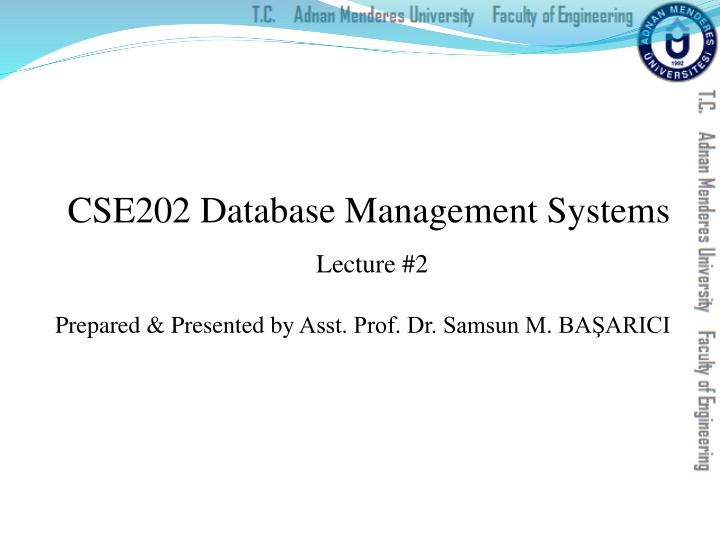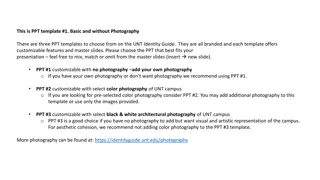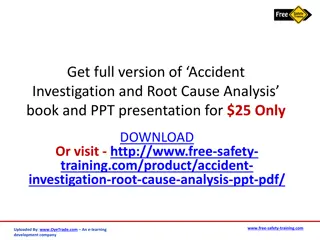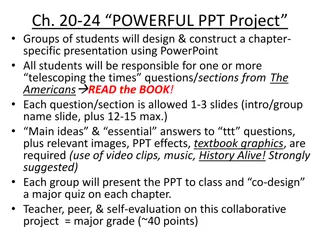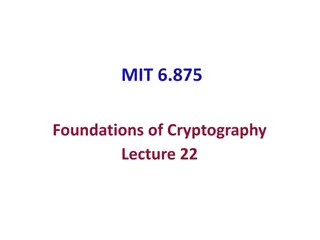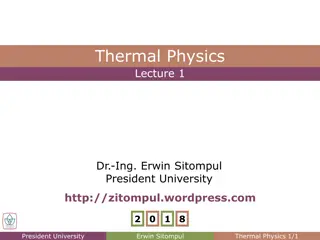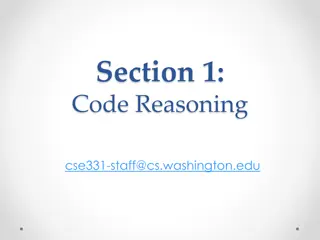CSE202 Database Management Systems
The basics of relational algebra and calculus in database management, covering unary and binary relational operations, query examples, tuple and domain relational calculus. Explore the set of operations and declarative language used for specifying relational queries.
Download Presentation

Please find below an Image/Link to download the presentation.
The content on the website is provided AS IS for your information and personal use only. It may not be sold, licensed, or shared on other websites without obtaining consent from the author.If you encounter any issues during the download, it is possible that the publisher has removed the file from their server.
You are allowed to download the files provided on this website for personal or commercial use, subject to the condition that they are used lawfully. All files are the property of their respective owners.
The content on the website is provided AS IS for your information and personal use only. It may not be sold, licensed, or shared on other websites without obtaining consent from the author.
E N D
Presentation Transcript
CSE202 Database Management Systems Lecture #2 Prepared & Presented byAsst. Prof. Dr. Samsun M. BA ARICI
Part 2 Relational Algebra & Relational Calculus 2
Learning Objectives Understand and perform following operations: Unary Relational Operations: SELECT and PROJECT Relational Algebra Operations from Set Theory Binary Relational Operations: JOIN and DIVISION Additional Relational Operations Explain some examples of queries in relational algebra Understand the tuple relational calculus Understand the domain relational calculus 3
Outline Relational operations Unary operations Select Project Operations from Set Theory Binary operations Join Division Query examples in relational algebra Tuple relational calculus Domain relational calculus 4
The Relational Algebra and Relational Calculus Relational algebra Basic set of operations for the relational model Relational algebra expression Sequence of relational algebra operations Relational calculus Higher-level declarative language for specifying relational queries 5
Unary Relational Operations: SELECT and PROJECT The SELECT Operation Subset of the tuples from a relation that satisfies a selection condition: Boolean expression contains clauses of the form <attribute name> <comparison op> <constant value> or <attribute name> <comparison op> <attribute name> 6
Unary Relational Operations: SELECT and PROJECT (cont.) Example: <selection condition> applied independently to each individual tuple t in R If condition evaluates to TRUE, tuple selected Boolean conditions AND, OR, and NOT Unary Applied to a single relation 7
Unary Relational Operations: SELECT and PROJECT (cont.) Selectivity Fraction of tuples selected by a selection condition SELECT operation commutative Cascade SELECT operations into a single operation with AND condition 8
The PROJECT Operation Selects columns from table and discards the other columns: Degree Number of attributes in <attribute list> Duplicate elimination Result of PROJECT operation is a set of distinct tuples 9
Sequences of Operations and the RENAME Operation In-line expression: Sequence of operations: Rename attributes in intermediate results RENAME operation 10
Relational Algebra Operations from Set Theory UNION, INTERSECTION, and MINUS Merge the elements of two sets in various ways Binary operations Relations must have the same type of tuples UNION R S Includes all tuples that are either in R or in S or in both R and S Duplicate tuples eliminated 11
Relational Algebra Operations from Set Theory (cont.) INTERSECTION R S Includes all tuples that are in both R and S SET DIFFERENCE (or MINUS) R S Includes all tuples that are in R but not in S 12
The CARTESIAN PRODUCT (CROSS PRODUCT) Operation CARTESIAN PRODUCT CROSS PRODUCT or CROSS JOIN Denoted by Binary set operation Relations do not have to be union compatible Useful when followed by a selection that matches values of attributes 13
Binary Relational Operations: JOIN and DIVISION The JOIN Operation Denoted by Combine related tuples from two relations into single longer tuples General join condition of the form <condition> AND <condition> AND...AND <condition> Example: 14
Binary Relational Operations: JOIN and DIVISION (cont.) THETA JOIN Each <condition> of the form Ai Bj Ai is an attribute of R Bj is an attribute of S Ai and Bj have the same domain (theta) is one of the comparison operators: {=, <, , >, , } 15
Variations of JOIN: The EQUIJOIN and NATURAL JOIN EQUIJOIN Only = comparison operator used Always have one or more pairs of attributes that have identical values in every tuple NATURAL JOIN Denoted by * Removes second (superfluous) attribute in an EQUIJOIN condition 16
Variations of JOIN: The EQUIJOIN and NATURAL JOIN (cont.) Join selectivity Expected size of join result divided by the maximum size nR * nS Inner joins Type of match and combine operation Defined formally as a combination of CARTESIAN PRODUCT and SELECTION 17
A Complete Set of Relational Algebra Operations Set of relational algebra operations { , , , , , } is a complete set Any relational algebra operation can be expressed as a sequence of operations from this set 18
The DIVISION Operation Denoted by Example: retrieve the names of employees who work on all the projects that John Smith works on Apply to relations R(Z) S(X) Attributes of R are a subset of the attributes of S 19
Notation for Query Trees Query tree Represents the input relations of query as leaf nodes of the tree Represents the relational algebra operations as internal nodes 22
Additional Relational Operations Generalized projection Allows functions of attributes to be included in the projection list Aggregatefunctions and grouping Common functions applied to collections of numeric values Include SUM, AVERAGE, MAXIMUM, and MINIMUM 24
Additional Relational Operations (cont.) Group tuples by the value of some of their attributes Apply aggregate function independently to each group 25
Recursive Closure Operations Operation applied to a recursiverelationship between tuples of same type 27
OUTER JOIN Operations Outer joins Keep all tuples in R, or all those in S, or all those in both relations regardless of whether or not they have matching tuples in the other relation Types LEFT OUTER JOIN, RIGHT OUTER JOIN, FULL OUTER JOIN Example: 28
The OUTER UNION Operation Take union of tuples from two relations that have some common attributes Not union (type) compatible Partially compatible All tuples from both relations included in the result Tut tuples with the same value combination will appear only once 29
The Tuple Relational Calculus Declarative expression Specify a retrieval request nonprocedural language Any retrieval that can be specified in basic relational algebra Can also be specified in relational calculus 33
Tuple Variables and Range Relations Tuple variables Ranges over a particular database relation Satisfy COND(t): Specify: Range relation R of t Select particular combinations of tuples Set of attributes to be retrieved (requested attributes) 34
Expressions and Formulas in Tuple Relational Calculus General expression of tuple relational calculus is of the form: Truth value of an atom Evaluates to either TRUE or FALSE for a specific combination of tuples Formula (Boolean condition) Made up of one or more atoms connected via logical operators AND, OR, and NOT 35
Existential and Universal Quantifiers Universal quantifier ( ) Existential quantifier ( ) Define a tuple variable in a formula as free or bound 36
Transforming the Universal and Existential Quantifiers Transform one type of quantifier into other with negation (preceded by NOT) AND and OR replace one another Negated formula becomes unnegated Unnegated formula becomes negated 39
Safe Expressions Guaranteed to yield a finite number of tuples as its result Otherwise expression is called unsafe Expression is safe If all values in its result are from the domain of the expression 41
The Domain Relational Calculus Differs from tuple calculus in type of variables used in formulas Variables range over single values from domains of attributes Formula is made up of atoms Evaluate to either TRUE or FALSE for a specific set of values Called the truth values of the atoms 42
The Domain Relational Calculus (cont.) QBE language Based on domain relational calculus 43
Next Lecture Structured Query Language SQL 44
References Ramez Elmasri, Shamkant Navathe; Fundamentals of Database Systems , 6th Ed., Pearson, 2014. Mark L. Gillenson; Fundamentals of Database Management Systems , 2nd Ed., John Wiley, 2012. Universit t Hamburg, Fachbereich Informatik, Einf hrung in Datenbanksysteme, Lecture Notes, 1999 45
